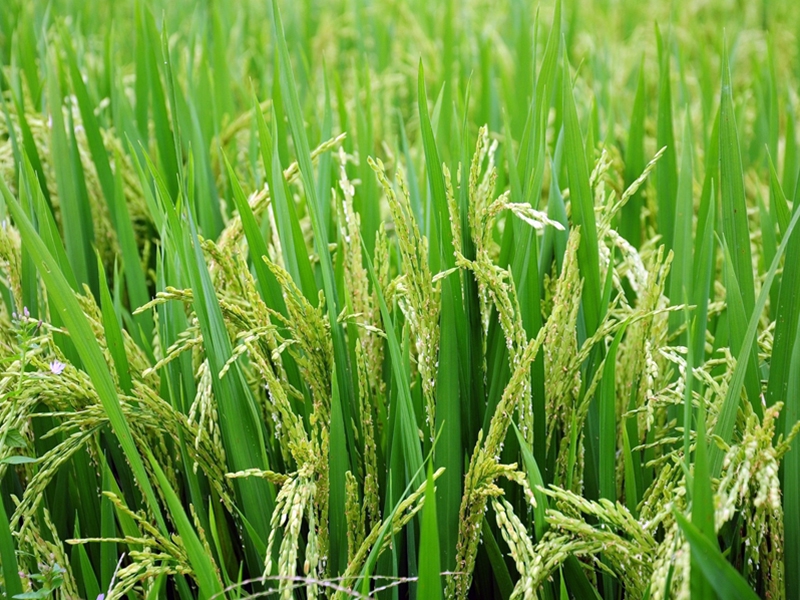
Andy Weir’s bestselling 2011 book, The Martian, features botanist Mark Watney’s efforts to grow food on Mars after he becomes stranded there. While Watney’s initial efforts focus on growing potatoes, new research presented at the 54th Lunar and Planetary Science Conference by a team of interdisciplinary researchers from the U of A suggests future Martian botanists like Watney may have a better option: growing rice.
As outlined in the team’s abstract, Rice Can Grow and Survive in Martian Regolith with Challenges That Could be Overcome Through Control of Stress-Related Genes, one of the biggest challenges to growing food on Mars is the presence of perchlorate salts, which have been detected in the planet’s soil and are generally considered to be toxic for plants.
The team was able to simulate Martian soil using basaltic rich soil mined from the Mojave Desert, called the Mojave Mars Simulant, or MMS, which was developed by scientists from NASA and the Jet Propulsion Laboratory.
The teams then grew three varieties of rice, including one wild-type and two gene-edited lines with genetic mutations that better enable them to respond to stress, such as drought, sugar starvation or salinity. These varieties were grown in the MMS, as well as a regular potted mix and a hybrid of the two. While plants were able to grow in the Martian simulant, they were not as developed as those grown in the potting soil and hybrid mix. Replacing just a quarter of the Martian simulant with potting soil resulted in improved development.
The team also experimented with the amount of perchlorate in the soil, finding that 3 grams per kilogram was the threshold beyond which nothing would grow, while mutant strains could still root in 1 gram per kilogram.
Their findings suggest that there might be a way forward for genetically modified rice to find purchase in Martian soil.

From left: Peter James Gann, Abhilash Ramachandran, Dominic Dharwadker, Yheni Dwiningsih and Vibha Srivastava.
Next steps will include experimenting with a newer Martian soil simulant called the Mars Global Simulant, as well as other rice strains that have increased tolerance for higher salt concentrations. An important part of the research will be determining to what degree perchlorate may be leeching into the plant from the soil. Farther down the road, the researchers would like to introduce rice into a closed habitat chamber and place it in a Mars simulation chamber that replicates the temperature and atmosphere of the planet.
Whether humans ever colonize Mars, the team’s research could have applications here on Earth. Second author on the abstract, Abhilash Ramachandran, a post-doctoral fellow at the Arkansas Center for Space and Planetary Sciences, noted that he spoke with an Australian researcher from an area where the soil had high salinity, and saw their work as a potential way to grow food there. He added, “We could use Earth as a terrestrial analog before the seeds ever get sent to Mars.”
First author on the abstract, Peter James Gann, a doctoral student in cell and molecular biology, said that the project began when he met Ramachandran for coffee in the student union. “He was new here at the university, and we shared the things we were doing in our respective laboratories. Since he works on planetary science, and I specialize in cell and molecular biology, we decided to try out plants.”
They were joined by co-authors Yheni Dwiningsih, a post-doctoral associate in plant sciences; Dominic Dharwadker, an undergraduate student in the Honors College; and Vibha Srivastava, a professor in the Department of Crop, Soil and Environmental Sciences who has a joint appointment with the U of A System Division of Agriculture.
Gann, for one, is pleased with how his initial conversation with Ramachandran has turned out. “Relevant and interesting research can emanate from talking to strangers over a cup of coffee or a glass of beer,” he said, before adding: “Ain't that cool?”
About the University of Arkansas: As Arkansas' flagship institution, the U of A provides an internationally competitive education in more than 200 academic programs. Founded in 1871, the U of A contributes more than $2.2 billion to Arkansas’ economy through the teaching of new knowledge and skills, entrepreneurship and job development, discovery through research and creative activity while also providing training for professional disciplines. The Carnegie Foundation classifies the U of A among the few U.S. colleges and universities with the highest level of research activity. U.S. News & World Report ranks the U of A among the top public universities in the nation. See how the U of A works to build a better world at Arkansas Research News.
Topics
- Research & Innovation
- Sustainability & Resilience
- Science
- Natural Environment
- Food & Nutrition
- Technology
- Dale Bumpers College of Agricultural, Food & Life Sciences
- Fulbright College of Arts & Sciences
- Graduate School & International Education
- Honors College
- UA System
- Department of Chemistry and Biochemistry
- Department of Crop, Soil and Environmental Sciences
- Space and Planetary Sciences Program
- Cell and Molecular Biology Program
- UA Division of Agriculture
Contacts
Peter James Gann, doctoral candidate in Cell and Molecular Biology Program
Fulbright College of Arts and Sciences
607-425-6312, pjicalia@uark.edu
Abhilash Vakkada Ramachandran, postdoctoral fellow at the Center for Space and Planetary Sciences
Fulbright College of Arts and Sciences
479-404-0275, av034@uark.edu
Hardin Young, assistant director of research communications
University Relations
479-575-6850,
hyoung@uark.edu